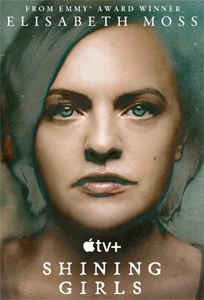Imagine Christopher Lloyd’s chalkboard-charted time-travel from “Back to the Future” cleanly plotted out on a sheet of paper. Now imagine that paper folded in half, with a pencil punched through it, like Sam Neill’s explanation of wormholes in “Event Horizon.” Now imagine it torn into pieces.
Now imagine the scraps in the garbage, and you have the 2022 miniseries “Shining Girls,” a time-travel show so confusing that even YouTube’s “Ending Explained” videos can’t agree on what the hell happened. Indeed, many of them are clickbait; the creators don’t have much to say other than “time-jumping” and “supernatural house.”
Based on a 2013 novel by Lauren Beukes, this eight-episode series created by Silka Luisa has good acting and strong set design and location scouting as it re-creates 1992 in Chicago – a home base of sorts — but also takes us back to the 1960s, 1980s, 1920s and 19th century.

“Shining Girls” (2022)
8 episodes, Apple TV Plus
Creator: Silka Luisa; based on the novel by Lauren Beukes
Stars: Elisabeth Moss, Wagner Moura, Jaime Bell
Take the supernatural out of “Shining Girls,” and it might’ve been a compelling howcatchem. Kirby (everywoman Elisabeth Moss) – the lone survivor of attacks by serial killer Harper (creepy Jaime Bell) where her stomach is sliced in the design of a cross – wants to catch the murderer. So does Chicago Sun-Times reporter Dan (suave Wagner Maura), partly to recover a career he has drank away, partly because he feels for Kirby.
Getting it right (or not)
As I have worked in several newsrooms, here’s a tangent on the portrayal of the Sun-Times. In terms of set design, it’s excellent, featuring those computers with green type on black screens, and a basement archive section. In the pre-internet age, Kirby pulls clips when reporters need background. I love the vibe.
Dan uses Kirby as a source, and for some reason doesn’t tell his editor, Abby (Erika Alexander, doing yeoman’s work). Kirby even helps with the investigation (!), accompanying Dan on police records searches and interviews of subjects.
When Abby finds out about this, she initially is just annoyed, but eventually she puts Kirby on a leave of absence. Kirby is miffed, and “Shining Girls” intends for us to be miffed on her behalf, but Abby is very much in the right.
The way this would’ve played out IRL is Dan would’ve told Abby an employee is his source, and Kirby would’ve been placed on paid leave during the coverage of the story. (Or perhaps she would be dismissed with a severance check and glowing reference letters.) Dan’s articles would make it clear that Kirby is a Sun-Times employee on leave, or a former employee; any appearance of bias can only be countered with transparency.

Most viewers won’t care about that any more than I care about the inaccuracies in court, police or hospital shows, but I point it out for the sake of being thorough. And also because I know what to say about newspapers. I have no idea about “Shining Girls’ ” time travel.
The (endless) search for answers
In episode six, we do learn about the Magic House; I temporarily appreciated the episode for its illusion of Answers, although I did miss Dan and Kirby. Harper can step through the Magic House’s doors and travel any time between 1920 and 1992. He doesn’t know why he can’t go beyond that. And neither do we … ever. Because neither do the writers.
While “Shining Girls” does nominally end its story (rather than being a “to be continued”), it certainly doesn’t answer all its questions. Broadly, the structure is like this: Episode one introduces two questions; episode two answers one and introduces two more; episode three answers one and introduces three more; and so forth.
You can almost enjoy “Shining Girls” as a straight-ahead story of a woman catching a serial killer and getting her life back, and (due to the bizarro-time aspect) also saving the other victims. Interestingly (at first blush), astronomer Jin-Sook (Phillipa Soo) is killed by Harper in episode one, but then she continues to be a character thanks to the time-hopping. (The Chicago planetarium is another nice setting to spend time in.)
By episode eight, it’s clear that not everything will be explained; this show has run off the rails and leaked anhydrous ammonia. It’s amazing that it held my attention for the first seven episodes simply by being technically well made, so I will give it credit for that.
Did it even need to be supernatural?
But just as newspaper reporting needs a foundation of trust – Dan acknowledging his source, and being transparent if the one surviving victim works at the paper – a teleplay needs a foundation of internal rules and logic. It can’t just be a bunch of stuff thrown at the wall by the team of five supposed writers. Or was this a secret experiment by Apple TV Plus to see if artificial intelligence could write a miniseries without people noticing or caring?
The point that the murders of Chicago women across the decades have dimmed society, and that it will be lit up again with their resurrections, could potentially be powerful, but “Shining Girls” is bizarrely not interested in its shining girls. We only know two of them – the escapee Kirby and the murdered Jin-Sook. (A woman from episode two almost becomes a main character, but then is forgotten; the rest are corpses in grainy old Sun-Times photos.)
More so, the nonsensical (and arguably unnecessary!) supernatural aspect distracts from the tragedies. Moss and Bell do their darnedest to hawk this material on the street corner – and I’d be willing to follow the charismatic Moura into better material — but any foundation of narrative logic is in the recycling bin before we can even grasp the story. Next timeline, please.

